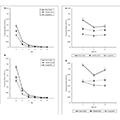Abstract
We investigated whether attention could be modulated through the implicit learning of temporal information in a rapid serial visual presentation (RSVP) task. Participants identified two target letters among numeral distractors. The stimulus-onset asynchrony immediately following the first target (SOA1) varied at three levels (70, 98, and 126 ms) randomly between trials or fixed within blocks of trials. Practice over 3 consecutive days resulted in a continuous improvement in the identification rate for both targets and attenuation of the attentional blink (AB), a decrement in target (T2) identification when presented 200–400 ms after another target (T1). Blocked SOA1s led to a faster rate of improvement in RSVP performance and more target order reversals relative to random SOA1s, suggesting that the implicit learning of SOA1 positively affected performance. The results also reveal “power law” learning curves for individual target identification as well as the reduction in the AB decrement. These learning curves reflect the spontaneous emergence of skill through subtle attentional modulations rather than general attentional distribution. Together, the results indicate that implicit temporal learning could improve high level and rapid cognitive processing and highlights the sensitivity and adaptability of the attentional system to subtle constraints in stimulus timing.
